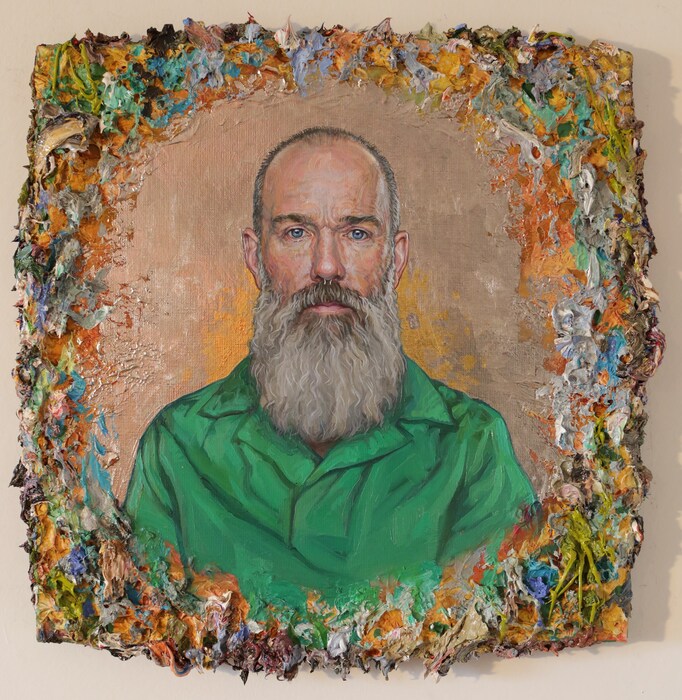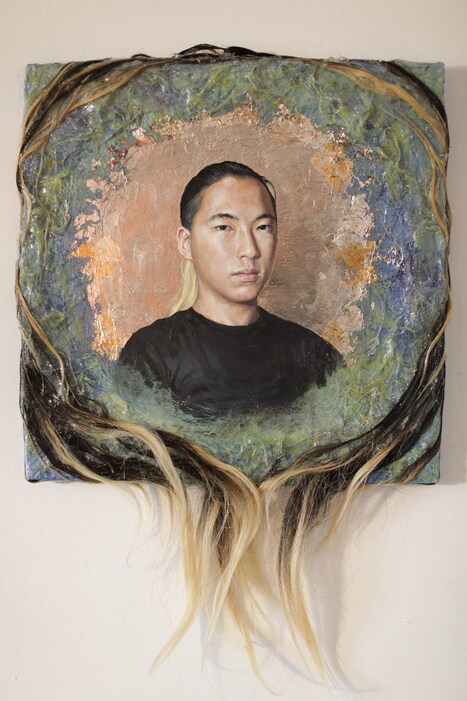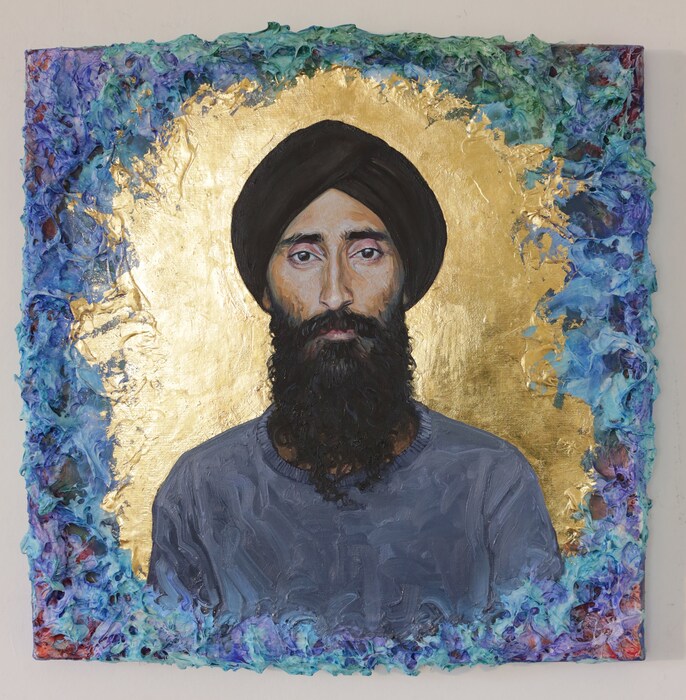Sandro Kopp’s visceral works, featuring his sitters’ hair, feature in a resonant new exhibition
There’s an eerie materiality to the work of Sandro Kopp – if you were to absorb one of his sculptural paintings quickly from the corner of your eye, you might be forgiven for believing you’d cast your eyes over one of his sitters themselves. Their respective images are created with a painstaking attention to detail over what is often a period of many years. Perhaps most fascinatingly though, their actual physical matter – strands of hair, lovingly donated by some of the sitters – are used as lines themselves within the works, built up in thick layers of paint, to frame their faces. So in fact, they are real, in a way – consecrated with a gleaming metallic background, and preserved forevermore.
A series of Kopp’s powerful portraits feature alongside the work of 11 other artists (Ellen Berkenblit, Lea Draeger, Sofia Goscinski, Bjarne Melgaard, Bjørn Melhus, Jonathan Meese, Otto Muehl, Sabine Pigalle, Iris Schomaker, Spencer Sweeney and Erwin Wurm) in Elective Affinities, a show inspired by the elusive Goethe novel of the same name, and held in one of the early centres of Austrian Actionism, Sammlung Friedrichshof. Here, he tells us more about his practice, and its place within the show.
On Friedrichshof’s infamous art commune…
“The thing about Friedrichshof, and in Austria it’s infamous, is that it was something like secular art cult. There was a lot of sex involved, and that was the thing that attracted a lot of people; at its height there were about 500 people all living in this place, out in the middle of nowhere, and at the opening I met four or five people from the original community. It all fell apart because Otto Muehl, who founded it and who was the figure behind it all, did some horrible things – they took him to court and he went to jail. After some years, the centre of the commune was turned into this beautiful public museum, which shows pieces from the Actionist archive alongside contemporary works.
“Life at the commune involved lots of psychological exercises which involved being degraded in front of the group. I asked two people who were there at the time in the 70s, why would you go there? You give all your belongings to the community – those were the conditions, that anything you owned became the community’s – but also, anything the community owned became yours. And they said, they were having fun! They were the cool kids, and it was amazing. There was no spiritual aspect to it; it was just, ‘lets make some art, and shag like rabbits’.”

On the resonance of the German word ‘verwandtschaft’…
“‘Verwandtschaft’ means ‘affinity’, but also, the noun ‘relative’, so it’s about choosing the people that you want to be in a family with, as much as in a relationship with – which, for my work, does really make sense. It also plays a big role, for example, with Jonathan Meese’s work. He’s a very very interesting artist from Germany. He works around themes of Wagner – so for him the affinity with Wagner and Wagnerian characters is super important. It’s about a kind of chosen affinity to a mythology, as much as to a particular person. And then there’s Erwin Wurm – he has these beautiful little pink sculptures in the various corners of the space. With both of those guys – and also a number of the other works in the show, and definitely all the Actionist stuff – for me, the show is as much about the body, as it is about this whole societal thing of chosen society. It’s really very body-centric.”

On what ‘elective affinities’ means to him…
“Most of, if not all of, the people who were the sitters for my series in the show are, in their own way, artists as well. For me the reason that I do portraits in the first place is very related to the whole idea of elective affinities, because I want be with that person’s presence. For the sitting I don’t like working from photographs, ever, I need to be in the presence of the other person as the germination of making any portrait. I’ll come back to that moment, and I will use photographs, just because I don’t always have those people around – but they’re always taken in that moment. They sort of draw me back into that moment of being present together.
“I’ve found with the pieces that I have in this show, which are part of a series of these very slowly built up, very worked pieces, it has to be someone who I want to hang out with that much. I want to put them in this almost icon-like state. The metal leaf behind the portrait is a very short route to associating it with kind of Christian or Buddhist iconography. There’s a kind of saintly feeling to them, and I like that, because these are all people who I really love, and who I want to hang out with. If I’m going to spend three or four years, like I do for a lot of these portraits, my subject has to be someone who I like, who I am familiar with, and who I want that elective affinity with. That’s what it means to me.”

On injecting his sitters’ presence into their portraits...
“I think there’s almost a sleight of hand, of making someone’s presence real with a thing. It’s an object, but it’s of the person as much as possible. I feel like the more time I can massage into it, by putting layers onto it, and thinking about the person more, a chemical process of condensation happens where they are a little bit there.
“I’ve taken it one step further with these pieces – and I have actually put some of the subjects into it, through the hair. I’ve taken the hair from the sitters and mixed it will acrylic and placed it as a kind of linear element, so it has this relationship with the drawing. It’s really great to work with, and also really gross to work with, so there’s a kind of body horror aspect to it, which fits with the Actionist idea very well.”
Elective Affinities runs until November 25, 2018, at Sammlung Friedrichshof, Austria.
